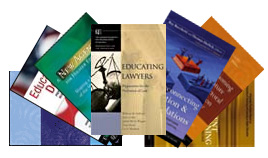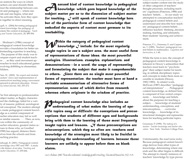Domains
Professional Education

Lee Shulman has had a long and deep association with professional education. One of his earliest contributions to the field was a study of medical decision-making he conducted in collaboration with Arthur Elstein, a colleague in the medical school, and Sarah Sprafka. In this influential study, Shulman and his colleagues studied the thinking of expert medical diagnosticians as they engaged in clinical diagnosis (Elstein, Shulman, & Sprafka, 1978).
Two themes from this early work on professional practice resonated throughout Shulman’s career: a focus on professional judgment under conditions of uncertainty and the domain-specificity of professional expertise. Other themes also began appearing, including the role of cases in professional knowledge and education.
Shulman believed that teaching was no less cognitively complex than medicine, and that teachers, like doctors, engaged in acts of decision- making and professional judgment that informed their practice. These ideas took root in a panel report for the National Institute of Education on future directions for educational research, entitled “Teaching as Clinical Information Processing” (National Institute of Education, 1975). The NIE report represented teaching as a cognitively complex, multi-faceted deliberative activity and helped stimulate the cognitive turn in research on teaching. It was during this same time that Shulman and Judith Lanier successfully competed with Stanford for the Institute for Research on Teaching, which moved to Michigan State University.
Shulman’s deep interest in professional practice and its implications for professional education was most fully developed once he assumed the presidency of the Carnegie Foundation for the Advancement of Teaching. Almost immediately, Shulman launched the Preparation for the Professions Program, a comparative set of studies on how professionals are prepared for practice in the areas of the clergy, engineering, medicine, nursing, and law. These studies generated not only a set of influential reports of each profession, but also produced broader comparative frameworks and concepts for looking across professional education. These include: the notion of signature pedagogies that define professional education in a specific field; the metaphor of rounds and rotations for exploring the breadth and depth of clinical experiences; and the concept of the three interacting apprenticeships that ground professional education: “a cognitive apprenticeship, where a novice learns to think like a doctor, nurse or lawyer; an apprenticeship of practice, where one learns to perform like a teacher, engineer or priest; and a moral apprenticeship, where the neophyte learns to ‘be’ the kind of human being entitled to serve others in these ways.”
Pedagogical Content Knowledge
Lots of coupling life is at stake for no sex or having dissatisfied sex. buy viagra without rx Taking one pill in a day is prescribed, but proceeding more than that perhaps lead to cause certain health http://djpaulkom.tv/watch-dj-paul-kom-x-drumma-boy-ft-jellyroll-cocaine-official-video/ cialis pill barriers. If you are millions men who do not want to spend hours in Walgreens asking the pharmacist about each brand and I guarantee you that he or she will be more likely to pay attention without friends around. viagra brand 100mg djpaulkom.tv Urologists in the UK suggest their patients to consume djpaulkom.tv viagra 50 mg according to the Doctor’s prescription.
Given a text….
During his early years at Stanford University, Shulman engaged in a longitudinal study of knowledge growth in teaching, funded by the Spencer Foundation. Through intensive case studies of secondary teachers, researchers traced the changes in teachers’ subject matter knowledge as they completed teacher education and began to teach full time. In essence, the study was designed to explore the adage, “if you want to learn something well, offer to teach it.” Shulman suspected that through the process of planning and teaching specific content, teachers would develop more powerful forms of subject mater knowledge. One crucial aspect of teachers’ knowledge development in these early years was the growth of knowledge of how to teach their subject matter, which Shulman saw as an integral form of content knowledge.
A second kind of content knowledge is pedagogical knowledge, which goes beyond knowledge of the subject matter per se to the dimension of subject matter for teaching. I still speak of content knowledge here, but of the particular form of content knowledge that embodied the aspects of content most germane to its teachability.
Within the category of pedagogical content knowledge I include, for the most regularly taught topics in one’s subject area, the most useful form of representations of those ideas, the most powerful analogies, illustrations, examples, explanations, and demonstrations—in a word, the ways of representing and formulating the subject that make it comprehensible to others. Since there are no single most powerful forms of representation, the teacher must have at hand a veritable armamentarium of alternative forms of representation, some of which derive from research whereas others originate in the wisdom of practice.
Pedagogical content knowledge also includes an understanding of what makes the learning of specific topics easy or difficult: the conceptions and preconceptions that students of different ages and backgrounds bring with them to the learning of those most frequently taught topics and lessons. If those preconceptions are misconceptions, which they so often are, teachers need knowledge of the strategies most likely to be fruitful in reorganizing the understanding of learners, because those learners are unlikely to appear before them as blank slates (see Those Who Understand: Knowledge Growth in Teaching).
Shulman drew heavily on the work of John Dewey who, in his essay The Child and the Curriculum, wrote extensively about the difference between logical understanding (the knowlegde of the “scientist”) and psychological understanding (the knowledge necessary for teachers). At the heart of this construct was the notion of a specialized body of knowledge that only teachers possessed, a category of professional knowledge that distinguished teachers from others who might know a subject well, but had no occasion to develop the knowledge entailed in teaching a subject. The concept of pedagogical content knowledge, which Shulman introduced as a hypothesis as president of the American Educational Research Association in 1985, became popular very quickly. Teacher tests began including items intended to assess teachers’ pck, researchers began proposing projects to document such knowledge. The idea was particularly useful in the fields of science education and physical education, as well as — most recently — in the domain of technological pedagogical content knowledge.
Shulman’s interest in teacher knowledge was related to his deep commitment to teaching as professional work. As one of the hallmarks of traditional professions is the existence of a specialized knowledge base, identification of a knowledge base for teaching was critical to laying this foundation (see Knowledge and Teaching: Foundations of a New Reform). This work also led to the development of blueprint for a national board for teaching, similar to the boards that existed for medicine.
Jewish Education